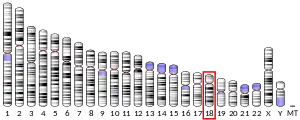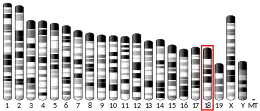AFG3L2
AFG3 ATPase family gene 3-like 2 (S. cerevisiae) is a protein that in humans is encoded by the AFG3L2 gene.[5]
This gene encodes a protein localized in mitochondria and closely related to paraplegin. The paraplegin gene is responsible for an autosomal recessive form of hereditary spastic paraplegia. This gene is a candidate gene for other hereditary spastic paraplegias or neurodegenerative disorders [5] as well as spastic ataxia-neuropathy syndrome.[6]
References
- GRCh38: Ensembl release 89: ENSG00000141385 - Ensembl, May 2017
- GRCm38: Ensembl release 89: ENSMUSG00000024527 - Ensembl, May 2017
- "Human PubMed Reference:". National Center for Biotechnology Information, U.S. National Library of Medicine.
- "Mouse PubMed Reference:". National Center for Biotechnology Information, U.S. National Library of Medicine.
- "Entrez Gene: AFG3 ATPase family gene 3-like 2 (S. cerevisiae)". Retrieved 2011-12-30.
- Pierson TM, Adams D, Bonn F, Martinelli P, Cherukuri PF, Teer JK, Hansen NF, Cruz P, Mullikin For The Nisc Comparative Sequencing Program JC, Blakesley RW, Golas G, Kwan J, Sandler A, Fuentes Fajardo K, Markello T, Tifft C, Blackstone C, Rugarli EI, Langer T, Gahl WA, Toro C (October 2011). "Whole-exome sequencing identifies homozygous AFG3L2 mutations in a spastic ataxia-neuropathy syndrome linked to mitochondrial m-AAA proteases". PLoS Genet. 7 (10): e1002325. doi:10.1371/journal.pgen.1002325. PMC 3192828. PMID 22022284.
External links
- Human AFG3L2 genome location and AFG3L2 gene details page in the UCSC Genome Browser.
Further reading
- Banfi, S.; Bassi, M. T.; Andolfi, G.; Marchitiello, A.; Zanotta, S.; Ballabio, A.; Casari, G.; Franco, B. (1999). "Identification and Characterization of AFG3L2, a Novel Paraplegin-Related Gene". Genomics. 59 (1): 51–58. doi:10.1006/geno.1999.5818. PMID 10395799.
- Cagnoli, C.; Mariotti, C.; Taroni, F.; Seri, M.; Brussino, A.; Michielotto, C.; Grisoli, M.; Di Bella, D.; Migone, N.; Gellera, C.; Di Donato, S.; Brusco, A. (2005). "SCA28, a novel form of autosomal dominant cerebellar ataxia on chromosome 18p11.22-q11.2". Brain. 129 (Pt 1): 235–242. doi:10.1093/brain/awh651. PMID 16251216.
- Mariotti, C.; Brusco, A.; Bella, D.; Cagnoli, C.; Seri, M.; Gellera, C.; Donato, S.; Taroni, F. (2008). "Spinocerebellar ataxia type 28: A novel autosomal dominant cerebellar ataxia characterized by slow progression and ophthalmoparesis". The Cerebellum. 7 (2): 184–188. doi:10.1007/s12311-008-0053-9. PMID 18769991. S2CID 8173189.
- Augustin, S.; Gerdes, F.; Lee, S.; Tsai, F. T. F.; Langer, T.; Tatsuta, T. (2009). "An intersubunit signaling network coordinates ATP hydrolysis by m-AAA proteases". Molecular Cell. 35 (5): 574–585. doi:10.1016/j.molcel.2009.07.018. PMC 2744646. PMID 19748354.
- Di Bella, D.; Lazzaro, F.; Brusco, A.; Plumari, M.; Battaglia, G.; Pastore, A.; Finardi, A.; Cagnoli, C.; Tempia, F.; Frontali, M.; Veneziano, L.; Sacco, T.; Boda, E.; Brussino, A.; Bonn, F.; Castellotti, B.; Baratta, S.; Mariotti, C.; Gellera, C.; Fracasso, V.; Magri, S.; Langer, T.; Plevani, P.; Di Donato, S.; Muzi-Falconi, M.; Taroni, F. (2010). "Mutations in the mitochondrial protease gene AFG3L2 cause dominant hereditary ataxia SCA28". Nature Genetics. 42 (4): 313–321. doi:10.1038/ng.544. PMID 20208537. S2CID 1703983.
- Edener, U.; Wöllner, J.; Hehr, U.; Kohl, Z.; Schilling, S.; Kreuz, F.; Bauer, P.; Bernard, V.; Gillessen-Kaesbach, G.; Zühlke, C. (2010). "Early onset and slow progression of SCA28, a rare dominant ataxia in a large four-generation family with a novel AFG3L2 mutation". European Journal of Human Genetics. 18 (8): 965–968. doi:10.1038/ejhg.2010.40. PMC 2987378. PMID 20354562.
- Cagnoli, C.; Stevanin, G.; Brussino, A.; Barberis, M.; Mancini, C.; Margolis, R. L.; Holmes, S. E.; Nobili, M.; Forlani, S.; Padovan, S.; Pappi, P.; Zaros, C. C.; Leber, I.; Ribai, P.; Pugliese, L.; Assalto, C.; Brice, A.; Migone, N.; Dürr, A.; Brusco, A. (2010). "Missense mutations in the AFG3L2 proteolytic domain account for ∼1.5% of European autosomal dominant cerebellar ataxias". Human Mutation. 31 (10): 1117–1124. doi:10.1002/humu.21342. PMID 20725928. S2CID 38251230.
This article is issued from Wikipedia. The text is licensed under Creative Commons - Attribution - Sharealike. Additional terms may apply for the media files.



